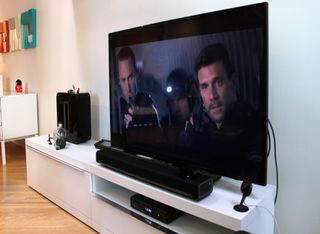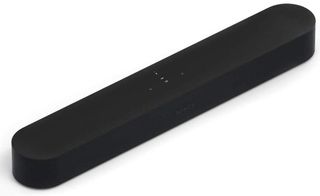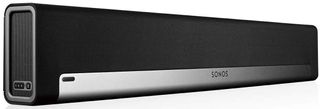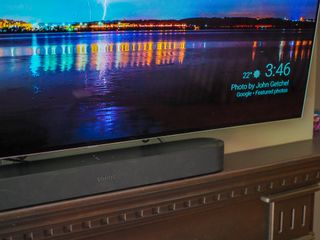Sonos Beam vs. Sonos Playbar: Which should you buy?


Our pick
The Sonos Beam is a great option for those who want to upgrade their TV's sound system. The compact size will fit just about anywhere without being too intrusive, and it will fill the room with fantastic, high-quality sound thanks to the woofers and tweeters inside the speaker. It also has built-in Alexa support, and it works with Siri through AirPlay 2.
For
- Small and compact size that delivers big, rich sound
- Great for small and medium-sized rooms
- Built-in Amazon Alexa integration, works with Siri through AirPlay 2.
- Plugs in via HDMI-ARC and supports CEC.
- Good value
Against
- Won't fill larger rooms with sound

Big and mighty
Sonos Playbar is designed to deliver full theater-quality sound to large rooms in your home. It's equipped with plenty of drivers to do so and can be used flat or upright on the wall without distorting the audio. It also works with Amazon Alexa, but that requires more setup than the Beam. However, since this product is older, it may be harder to find now.
For
- Has angled drivers that allow it to be used in any position
- Works best for larger rooms, can be mounted
- Features more power and drivers than the Beam
- Angled woofer at ends disperse the sound wider
- Has an Ethernet port
Against
- Larger size may require its own shelf or a wall mount setup
- Alexa not built-in
- Very expensive
- Now discontinued, so may be harder to find
Sonos is well known for delivering great audio products to the average consumer. But when it comes to the Sonos Beam vs. Playbar, the better option for most people is definitely the Beam. That's because the Sonos Beam is smaller but still packs in amazing sound quality, has built-in Alexa support, integrates with Apple AirPlay 2, and it's the cheaper option. But if your TV is in a large room, and you need to fill it up with theatrical sound without any possible distortion, then the mountable Playbar is probably the better call.
Sonos Beam vs. Playbar: Breaking it down

For most people, the Sonos Beam is going to be the better option when it comes down to the Sonos Beam vs. Playbar. The Beam is small and compact, making it easy to move around if necessary, and it should not take up much space with your current setup. Despite the Beam's smaller size, it still delivers rich audio throughout the room and works best for small and medium-sized spaces.
| Header Cell - Column 0 | Sonos Beam | Sonos Playbar |
|---|---|---|
| Size | 25.6 x 2.7 x 3.9 inches | 35.5 x 5.6 x 3.4 inches |
| Weight | 6.35 lbs. | 11.90 lbs. |
| Optimized for | Small to medium rooms | Large rooms |
| Amazon Alexa | Built-in | Requires Echo or Echo Dot with Sonos skill |
| AirPlay 2 | Yes | Only if another speaker that has it is grouped with Playbar |
| Pairs with other Sonos speakers | Yes | Yes |
| Third-party streaming services | Yes | Yes |
| Mountable | Yes | Yes |
The Sonos Playbar is bigger and heavier, which may require some additional setup on your part, such as having a dedicated shelf or getting mounted to the wall. However, it can give you a full theater-like audio experience since it produces higher quality sound due to the drivers and woofers inside. The angled drivers also make sure that no noise ever gets distorted and it is evenly dispersed in a wider area, no matter how you set it up.
Setting up the Beam is also much easier because it connects through HDMI-ARC and HDMI-CEC, allowing you to control the TV and soundbar together as a single unit. The Playbar only uses an optical cable, so you would need to control it separately. If you need to, the Beam can also be mounted so it's even more out of the way and less intrusive, but you'll need to separately purchase one of the best TV mounts for Sonos Beam.
Built-in Alexa integration in Beam also makes it a better choice for those who want to simplify things. The Playbar also works with Alexa, but only if you have separate Echo or Echo Dots around the house. You also have to use the Sonos skill through the Amazon Alexa app, requiring some extra steps. The Beam also supports Siri voice commands through AirPlay 2, which is missing from the Playbar. A workaround for the Playbar is grouping it with other speakers that do support AirPlay 2, allowing the audio to play anywhere.
Sonos Beam vs. Playbar: Which should you buy?
Again, for most people, the Beam is the better buy due to the features and price. Plus, the audio quality is still great for what it's worth. It's built around simplicity, making it easy to set up, store away, and use Alexa and your TV without any extra devices. However, if you want the best sound that's capable of making the room shake, then Playbar is the way to go. Just remember that a new unit costs almost twice as much as the Beam, although the sound quality justifies the price.
Since the Sonos Playbar is an older product by this point, it can be a little harder to find. I think a better comparison nowadays would be Sonos Beam vs. Sonos One if you want to stay in the Sonos ecosystem.
Master your iPhone in minutes
iMore offers spot-on advice and guidance from our team of experts, with decades of Apple device experience to lean on. Learn more with iMore!

Our favorite soundbar
Sonos Beam is an excellent soundbar for your home entertainment system. It's small enough to fit virtually anywhere, provides great sound for smaller rooms, and has built-in Amazon Alexa integration and Siri through AirPlay 2.

Make the entire room shake with powerful sound
The Sonos Playbar is a bit older and harder to find at this point, but it's immensely powerful in terms of sound quality for your home entertainment setup. The powerful drivers will make the room shake with sound, and it works in both flat and upright positions without ever having audio distortion. The larger size may require the soundbar to be mounted if there isn't enough room.
Christine Romero-Chan was formerly a Senior Editor for iMore. She has been writing about technology, specifically Apple, for over a decade at a variety of websites. She is currently part of the Digital Trends team, and has been using Apple’s smartphone since the original iPhone back in 2007. While her main speciality is the iPhone, she also covers Apple Watch, iPad, and Mac when needed.
When she isn’t writing about Apple, Christine can often be found at Disneyland in Anaheim, California, as she is a passholder and obsessed with all things Disney, especially Star Wars. Christine also enjoys coffee, food, photography, mechanical keyboards, and spending as much time with her new daughter as possible.
Most Popular



